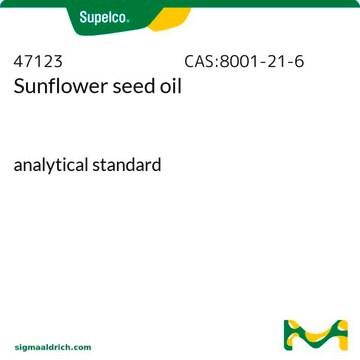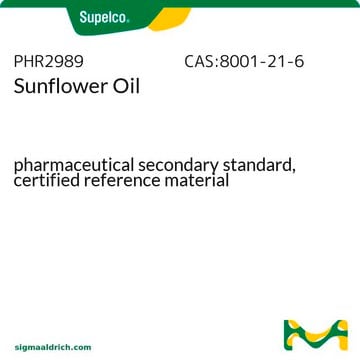W530285
Sunflower oil
Certified organic (NOP)
Synonym(s):
Sunflower seed oil from Helianthus annuus
Sign Into View Organizational & Contract Pricing
All Photos(1)
About This Item
Recommended Products
grade
Certified organic (NOP)
Kosher
refractive index
n20/D 1.475
application(s)
flavors and fragrances
Documentation
see Safety & Documentation for available documents
food allergen
no known allergens
Organoleptic
fatty; waxy
Looking for similar products? Visit Product Comparison Guide
General description
Sunflower oil, a widely used vegetable oil, is obtained from the seeds of sunflower plant (Helianthus annuus). It is generally composed of fatty acids such as linoleic, stearic, oleic and palmitic acid. It also contains high amounts of α-tocopherol.
Legal Information
Certified organic by MOSA
Supplementary Hazards
Storage Class Code
10 - Combustible liquids
WGK
WGK 3
Flash Point(F)
>230.0 °F
Flash Point(C)
> 110 °C
Personal Protective Equipment
dust mask type N95 (US), Eyeshields, Gloves
Certificates of Analysis (COA)
Search for Certificates of Analysis (COA) by entering the products Lot/Batch Number. Lot and Batch Numbers can be found on a product’s label following the words ‘Lot’ or ‘Batch’.
Already Own This Product?
Find documentation for the products that you have recently purchased in the Document Library.
Sunflower: Chemistry, Production, Processing, and Utilization (2015)
Minzhong Yu et al.
BioMed research international, 2018, 4374087-4374087 (2019-01-16)
Lutein, RR-zeaxanthin, and RS-zeaxanthin (L-Z) are antioxidants which can reduce endoplasmic reticulum stress (ERS) and oxidative stress (OS), and ameliorate neurodegenerative diseases. However, their treatment effect in the Pde6b
Influence of seed development and seed position on oil, fatty acids and total tocopherol contents in sunflower (Helianthus annuus L.).
Turkish Journal of Agriculture and Forestry, 29(3), 179-186 (2005)
Francis Alarcón et al.
Talanta, 100, 439-446 (2012-11-13)
The potential of microwave-assisted liquid-liquid and solid phase extraction coupled with fluorescence spectroscopy and employing one- to three-way spectral data was assessed in terms of their capacity for the rapid detection of heavy polycyclic aromatic hydrocarbons (PAHs) in olive and
M A De la Rubia et al.
Water science and technology : a journal of the International Association on Water Pollution Research, 67(2), 410-417 (2012-11-22)
Due to the chemical and physical structure of a lignocellulosic biomass, its anaerobic digestion (AD) is a slow and difficult process. In this paper, the results obtained from a batch biochemical methane potential (BMP) test and fed-batch mesophilic AD assays
Our team of scientists has experience in all areas of research including Life Science, Material Science, Chemical Synthesis, Chromatography, Analytical and many others.
Contact Technical Service








